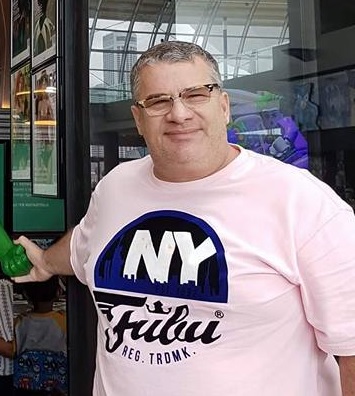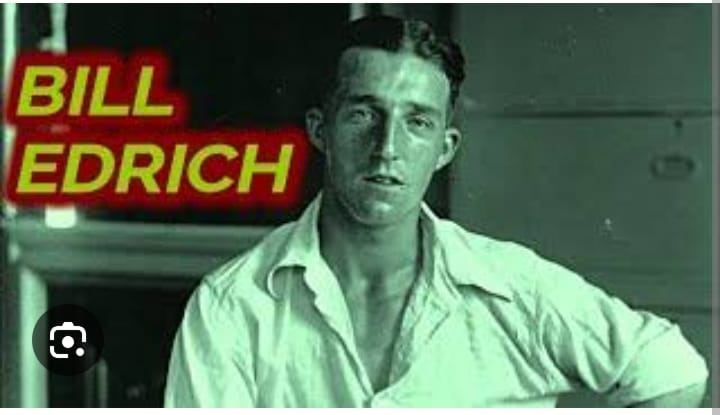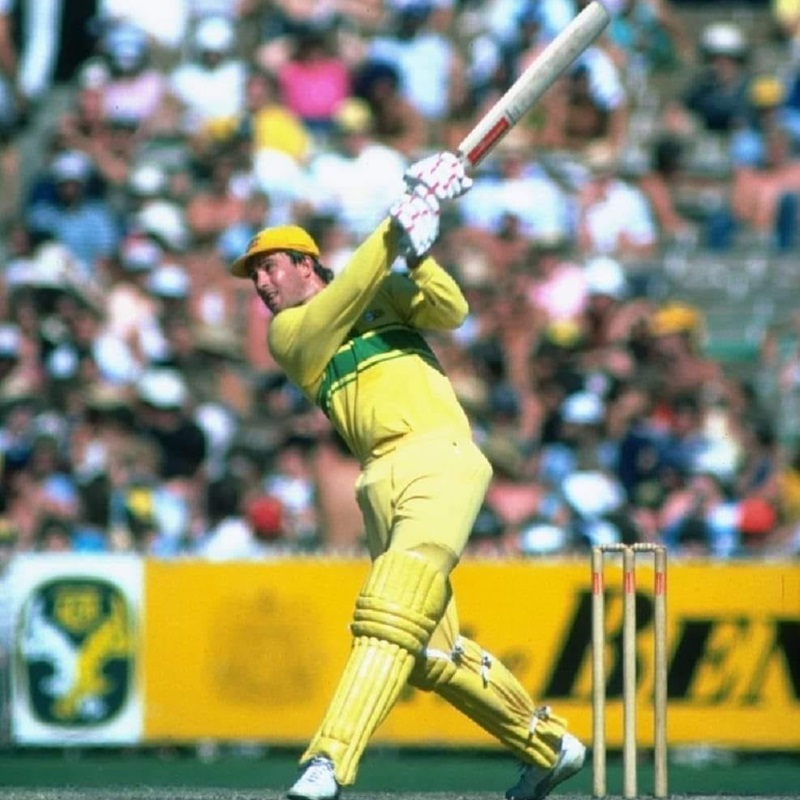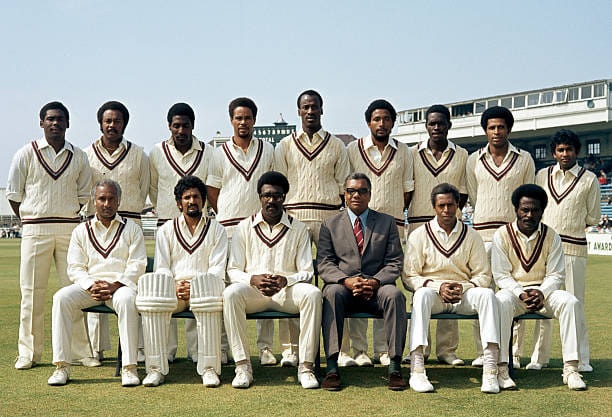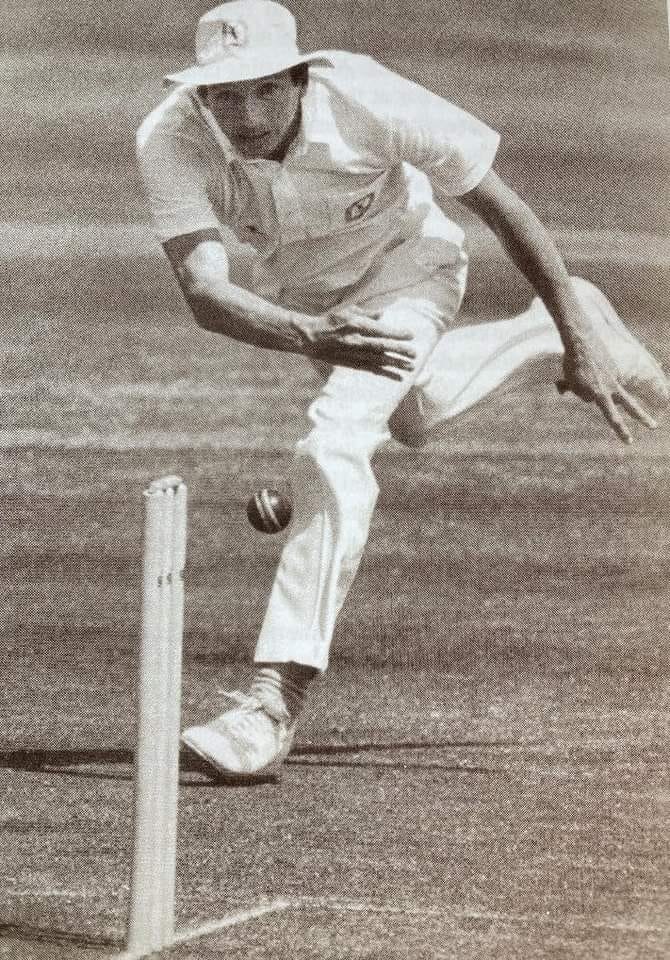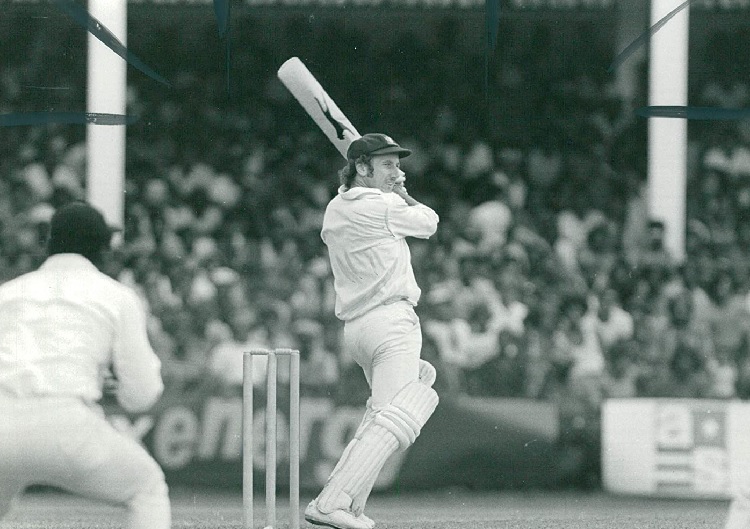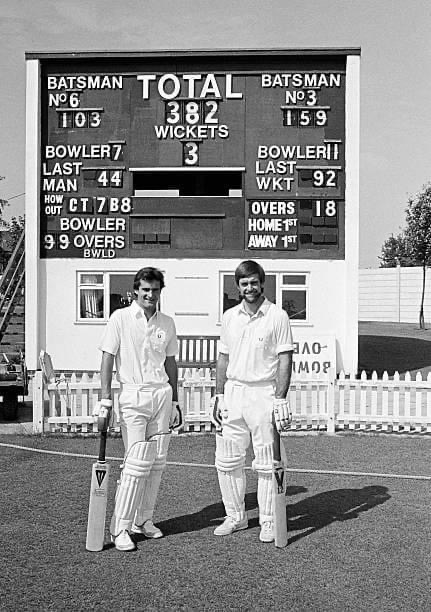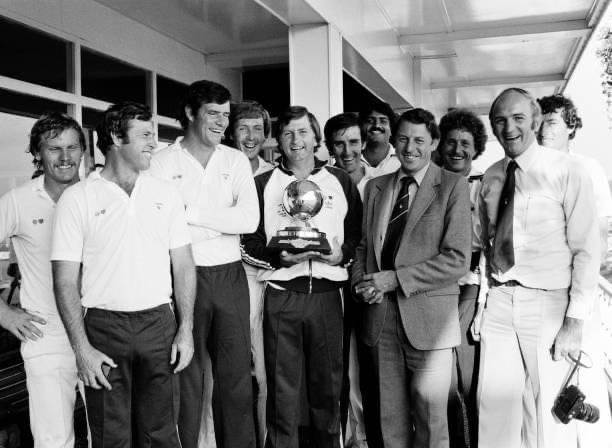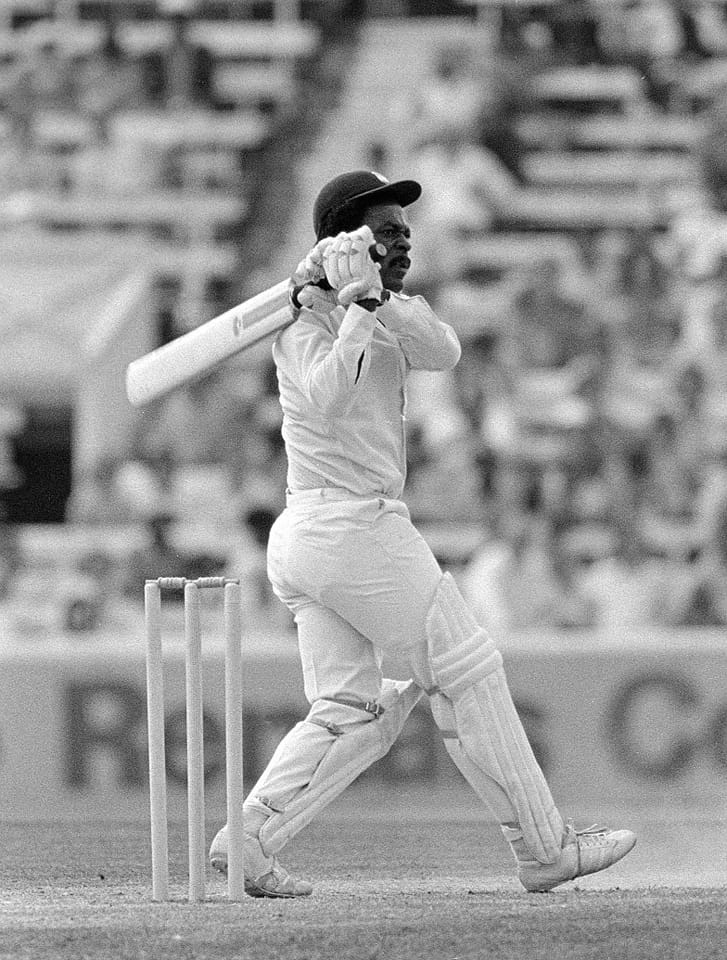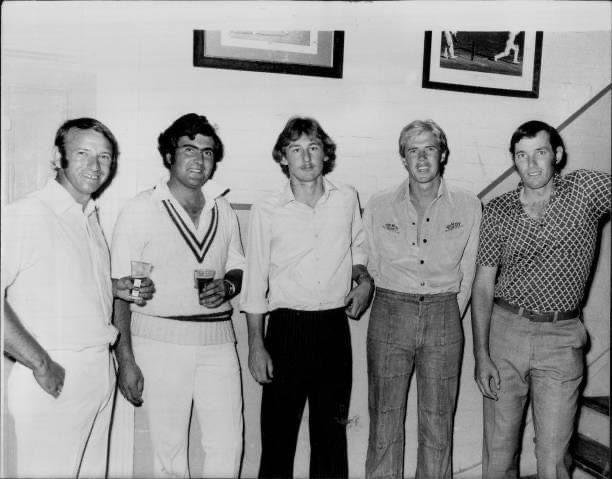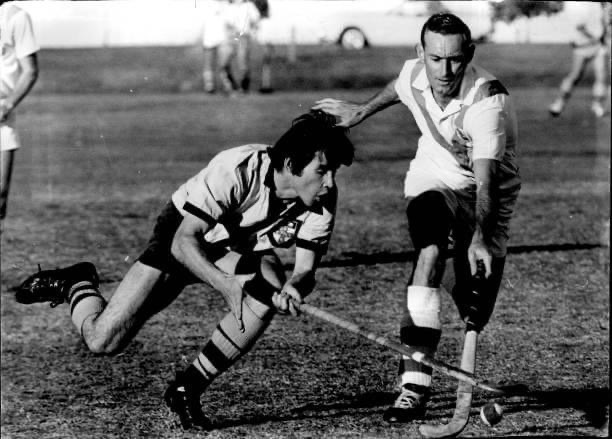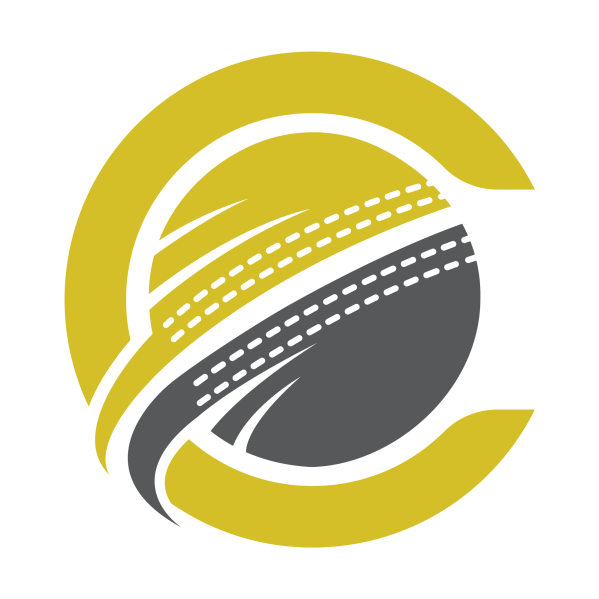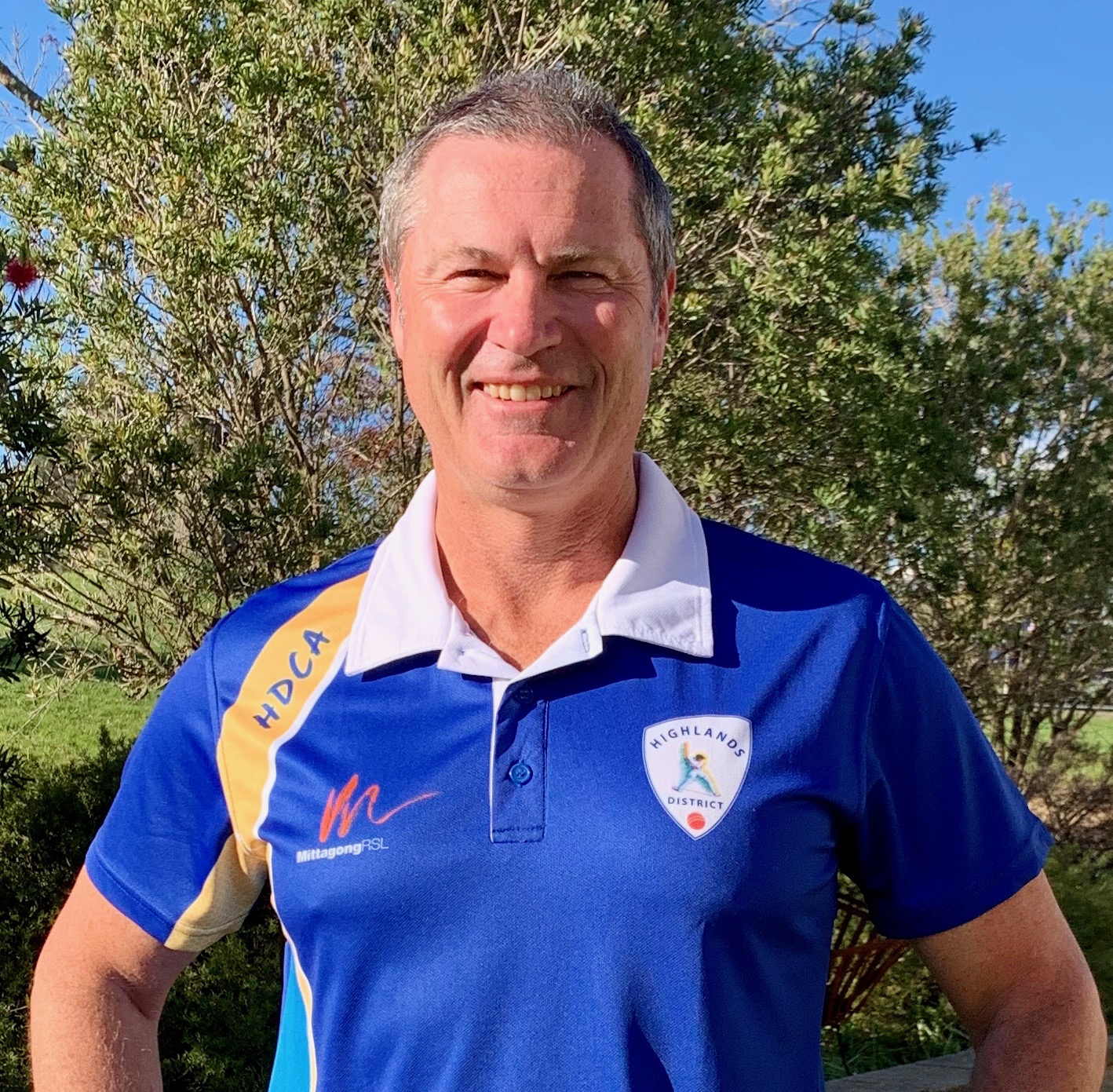About Me
Partner Sponsors
My Activity
question
Q: David William Gregory (15 April 1845 – 4 August 1919) was an Australian cricketer. A right-handed batsman, Gregory was the first Australian national cricket captain, leading the side for the first three recognised Test matches between England and Australia in March and April 1877 and January 1879. Gregory was also the captain of the NSW team, notably during the Sydney Riot of 1879 when he rebelled against an unpopular decision by Victorian umpire George Coulthard during a game against the touring English team.
Gregory was part of a large cricketing family: his father, Edward William Gregory, was a "capable cricketer" with 8 sons, 5 of whom played for NSW in international or intercolonial matches between 1861 and 84; in all, 20 of Edward William Gregory's descendants represented NSW in cricket and other sports.
David William Gregory was a man of striking appearance, he "looked like an Old Testament prophet not long out of training college."
Gregory was part of a large cricketing family: his father, Edward William Gregory, was a "capable cricketer" with 8 sons, 5 of whom played for NSW in international or intercolonial matches between 1861 and 84; in all, 20 of Edward William Gregory's descendants represented NSW in cricket and other sports.
David William Gregory was a man of striking appearance, he "looked like an Old Testament prophet not long out of training college."
question
Q: Syed Mushtaq Ali was an Indian cricketer, a right-handed opening batsman who holds the distinction of scoring the first overseas Test century by an Indian player when he scored 112 against England at Old Trafford in 1936.
Mushtaq Ali was observed by C. K. Nayudu at Indore at the age of 13 and helped to develop his cricketing skills. In total, he played in 11 Tests. He made his debut in the Test against England at Calcutta, 5–8 Jan 1934, and played his last Test against England at Madras, 6–10 Feb 1952, at the age of 38. - Cricket Cosmos
Mushtaq Ali was observed by C. K. Nayudu at Indore at the age of 13 and helped to develop his cricketing skills. In total, he played in 11 Tests. He made his debut in the Test against England at Calcutta, 5–8 Jan 1934, and played his last Test against England at Madras, 6–10 Feb 1952, at the age of 38. - Cricket Cosmos
question
Q: Bill Edrich DFC (1916 – 1986) was a first-class cricketer who played for Middlesex, Marylebone Cricket Club (MCC), Norfolk and England.
His three brothers, Brian, Eric, and Geoff, and also his cousin, John, all played first-class cricket. Locally in Norfolk the Edriches were able to raise a full team of eleven. In 1938 a team composed entirely of Edriches beat Norfolk in a one-day match.
Playing association football as an amateur for Norwich City and Tottenham Hotspur during the 1930s
A Wisden Cricketer of the Year in the 1940 edition of Wisden.
His three brothers, Brian, Eric, and Geoff, and also his cousin, John, all played first-class cricket. Locally in Norfolk the Edriches were able to raise a full team of eleven. In 1938 a team composed entirely of Edriches beat Norfolk in a one-day match.
Playing association football as an amateur for Norwich City and Tottenham Hotspur during the 1930s
A Wisden Cricketer of the Year in the 1940 edition of Wisden.
https://www.cricconnect.com/profile/325/joe-maiorana/blog/2069/bill-edrich-dfc-a-maverick
blog post
Bill Edrich DFC (1916 – 1986) was a first-class cricketer who played for Middlesex, Marylebone Cricket Club (MCC), Norfolk and England. ...
question
Q: Except for his debut, Jack Russell wore the same white hat throughout his first-class career while keeping wicket, often with his collar up and sunglasses on. "It's washed twice a season, and to dry it,
I use a glass biscuit jar, a tea cosy and a tea towel," Russell wrote in his autobiography. "The hat fits on top of all three, and is then, after starching, placed in the airing cupboard, thereby keeping its shape."
But in 1994 in Barbados, in an attempt to dry it faster, Russell put his hat in an oven, ending up charring it.
Two years later, the organising committee of the 1996 World Cup decreed that Russell wear coloured headgear to go with England's blue jersey. He refused and threatened to walk out of the tournament. After frantic fax exchanges between Calcutta and London, headed "Jack Russell Hat Crisis", the World Cup technical committee allowed Russell to wear his white floppy.
When Russell retired in 2006, his former captain Mike Atherton described his hat as a "dirty, smelly, grubby, patched-up, stitched-up, upside-down-flowerpot-of-a-thing". Atherton had reason to loathe it as it was the cause of many confrontations with the suits.
In 1998, then ECB chairman Ian MacLaurin asked the players to wear the blue England cap for every game of the West Indies tour, but Russell would not budge. After multiple meetings, it was agreed that Russell would trim the issued hat to his comfort.
For his final ODI, however, Russell did manage to pull off a hat-trick. He stitched a blue hat over his original and said goodbye to international cricket on his own terms.
(Vintage Cricket)
I use a glass biscuit jar, a tea cosy and a tea towel," Russell wrote in his autobiography. "The hat fits on top of all three, and is then, after starching, placed in the airing cupboard, thereby keeping its shape."
But in 1994 in Barbados, in an attempt to dry it faster, Russell put his hat in an oven, ending up charring it.
Two years later, the organising committee of the 1996 World Cup decreed that Russell wear coloured headgear to go with England's blue jersey. He refused and threatened to walk out of the tournament. After frantic fax exchanges between Calcutta and London, headed "Jack Russell Hat Crisis", the World Cup technical committee allowed Russell to wear his white floppy.
When Russell retired in 2006, his former captain Mike Atherton described his hat as a "dirty, smelly, grubby, patched-up, stitched-up, upside-down-flowerpot-of-a-thing". Atherton had reason to loathe it as it was the cause of many confrontations with the suits.
In 1998, then ECB chairman Ian MacLaurin asked the players to wear the blue England cap for every game of the West Indies tour, but Russell would not budge. After multiple meetings, it was agreed that Russell would trim the issued hat to his comfort.
For his final ODI, however, Russell did manage to pull off a hat-trick. He stitched a blue hat over his original and said goodbye to international cricket on his own terms.
(Vintage Cricket)
question
Q: On 7 March 2004, the Waugh brothers represented New South Wales for the final time, retiring with 50,907 first-class runs, 160 centuries and 457 wickets between them.
question
Q: Among the few undisputed blessings of the Packer revolution was that it gave Bob Taylor the Test career he had almost given up hope of having. An uncomplaining understudy for almost a decade,
Taylor's only cap before Alan Knott joined World Series Cricket was in New Zealand in 1970-71.
Knott was fit and keen to play, but this was skipper Ray Illingworth's way of rewarding Taylor's loyalty and patience.
Taylor was known as "Chat" by team-mates grateful for his willingness to talk, and often listen at length, to people he had never seen before and would never see again in tour receptions.
He went on to play another 56 Tests, confirming that in wicketkeeping skills he lost nothing by comparison with Knott.
As a batsman he was hardly a contributor. But it said everything about his sportsmanship that, at Adelaide in 1978-79, he walked for a tiny leg-side tickle when he was three short of what would have been his only England hundred.
Taylor's only cap before Alan Knott joined World Series Cricket was in New Zealand in 1970-71.
Knott was fit and keen to play, but this was skipper Ray Illingworth's way of rewarding Taylor's loyalty and patience.
Taylor was known as "Chat" by team-mates grateful for his willingness to talk, and often listen at length, to people he had never seen before and would never see again in tour receptions.
He went on to play another 56 Tests, confirming that in wicketkeeping skills he lost nothing by comparison with Knott.
As a batsman he was hardly a contributor. But it said everything about his sportsmanship that, at Adelaide in 1978-79, he walked for a tiny leg-side tickle when he was three short of what would have been his only England hundred.
question
Q: The Australian players celebrate with some beers on the dressing room balcony at the end of the 6th Test match between England and Australia at The Oval, London, England, 29th of August 1989. The match ended in a draw and Australia regained the Ashes, winning the six-match series 4-0.
Identified are (front row, left-right): Dean Jones, Steve Waugh, Mark Taylor, Carl Rackemann. Back row, Tim Zoehrer, Mike Walsh (scorer) and Allan Border.
Identified are (front row, left-right): Dean Jones, Steve Waugh, Mark Taylor, Carl Rackemann. Back row, Tim Zoehrer, Mike Walsh (scorer) and Allan Border.
question
Q: Martin Crowe
Batting average after 10 Tests: 20.68
Career average: 45.36
It took Crowe 5 Tests for his career average to cross 10, and 21 Tests to go past 30. With one Test century in 3 years, the pressure was on a young Crowe, but things turned around on the 1985 tour of the West Indies when he smashed 188 v an attack comprising Michael Holding, Malcolm Marshall, and Joel Garner.
By his 34th Test, his average had crossed 40, and he ended his career as New Zealand’s leading run-getter, eventually averaging in excess of 45 from 77 Tests.
Vintage Cricket
Batting average after 10 Tests: 20.68
Career average: 45.36
It took Crowe 5 Tests for his career average to cross 10, and 21 Tests to go past 30. With one Test century in 3 years, the pressure was on a young Crowe, but things turned around on the 1985 tour of the West Indies when he smashed 188 v an attack comprising Michael Holding, Malcolm Marshall, and Joel Garner.
By his 34th Test, his average had crossed 40, and he ended his career as New Zealand’s leading run-getter, eventually averaging in excess of 45 from 77 Tests.
Vintage Cricket
question
Q: Born in Deniliquin NSW Simon O Donnell was a multi-talented athlete who ended a promising Australian rules football career to focus on his cricket. He played a major role in Australia s resurgence as a dominating side and was a member of their World Cup winning side in 1987.
12 interesting facts about the Australian all-rounder, who like Yuvraj Singh, battled cancer and made a strong comeback to the national side.
1. Born on Australia Day
January 26 is the Australia Day, which is the official national day of the country. The day is of utmost significance to Australians as it marks the anniversary of the arrival of the first fleet of British ships in New South Wales in 1788. O Donnell was born on this day, which was the 175th anniversary. Not a bad day to be born on, it s a national holiday.
12 interesting facts about the Australian all-rounder, who like Yuvraj Singh, battled cancer and made a strong comeback to the national side.
1. Born on Australia Day
January 26 is the Australia Day, which is the official national day of the country. The day is of utmost significance to Australians as it marks the anniversary of the arrival of the first fleet of British ships in New South Wales in 1788. O Donnell was born on this day, which was the 175th anniversary. Not a bad day to be born on, it s a national holiday.
https://www.cricconnect.com/profile/325/joe-maiorana/blog/1955/simon-odonnell-was-born-on-this-day-in-1963
blog post
Born in Deniliquin NSW Simon O Donnell was a multi-talented athlete who ended a promising Australian rules football career to focus on his cricket. He played a major role in Australia s resurgence ...
question
Q: Bill Brockwell (1865 –1935) was an English cricketer. Although primarily remembered as a batsman, he began his career as a fast-medium bowler. With George Lohmann, Tom Richardson and William Lockwood carrying all before them, Brockwell had few opportunities until they declined.
A stylish and often brilliant batsman, strong in back play and a free hitter in front of the wicket, Brockwell also was a useful fast medium paced bowler and a smart fieldsman, notably at second slip where he succeeded George Lohmann--one of the surest catches ever seen in that position. First playing for the county in 1886, Brockwell matured slowly but it was difficult to find a place in the very powerful Surrey eleven of that period. However, from 1891 to 1902 he was a regular member of the side and played his last game in 1903 when the team were declining rapidly in all round strength.
In the very wet 1894 season, Brockwell, despite the consistently treacherous pitches, made a remarkable advance. He scored more runs (1,491) than any other player, and hit five centuries, and consequently was named as a Wisden Cricketer of the Year. He declined a great deal in 1895, but from the following year up to 1899, formed a formidable batting trio with Bobby Abel and Tom Hayward that made Surrey invincible on the perfect Oval pitches.
Bill played seven Test matches for England, all against Australia – one in 1893, five on the 1894/95 tour and a final match in 1899 – but was not a success at this level and averaged under 17 with a highest score of just 49. He played on for Surrey until 1903, but from 1900 his powers as a batsman declined severely and after two final first-class matches for London County he retired from cricket.
Sadly he was homeless in his last years and he passed away in poverty on the 1st July 1935 (aged 70)
William Brockwell was born on this day in 1865.
A stylish and often brilliant batsman, strong in back play and a free hitter in front of the wicket, Brockwell also was a useful fast medium paced bowler and a smart fieldsman, notably at second slip where he succeeded George Lohmann--one of the surest catches ever seen in that position. First playing for the county in 1886, Brockwell matured slowly but it was difficult to find a place in the very powerful Surrey eleven of that period. However, from 1891 to 1902 he was a regular member of the side and played his last game in 1903 when the team were declining rapidly in all round strength.
In the very wet 1894 season, Brockwell, despite the consistently treacherous pitches, made a remarkable advance. He scored more runs (1,491) than any other player, and hit five centuries, and consequently was named as a Wisden Cricketer of the Year. He declined a great deal in 1895, but from the following year up to 1899, formed a formidable batting trio with Bobby Abel and Tom Hayward that made Surrey invincible on the perfect Oval pitches.
Bill played seven Test matches for England, all against Australia – one in 1893, five on the 1894/95 tour and a final match in 1899 – but was not a success at this level and averaged under 17 with a highest score of just 49. He played on for Surrey until 1903, but from 1900 his powers as a batsman declined severely and after two final first-class matches for London County he retired from cricket.
Sadly he was homeless in his last years and he passed away in poverty on the 1st July 1935 (aged 70)
William Brockwell was born on this day in 1865.
question
Q: Trevor Barsby nicknamed "Tank" is a former Australian first-class cricketer who played for Queensland.
Trevor was an aggressive batsman, usually opening and often with Matthew Hayden
He is one of a select group of players to have appeared in 100 Sheffield Shield games for Queensland.
This milestone was reached in his last game, the 1996/97 Shield Final. Queensland won the game and their second Sheffield Shield trophy.
Barsby had played a large part in their inaugural championship win two seasons prior with an innings of 151 in the final against South Australia.
Trevor has been recognised for his contribution to QLD cricket with the Trevor Barsby Oval located at Deagon, Brisbane named in his honour.
He was the QLD Bulls coach from 2008 until 2010. His daughter Jemma Barsby plays for Queensland Fire and Brisbane Heat.
Trevor John Barsby was born on this day in 1964.
Trevor was an aggressive batsman, usually opening and often with Matthew Hayden
He is one of a select group of players to have appeared in 100 Sheffield Shield games for Queensland.
This milestone was reached in his last game, the 1996/97 Shield Final. Queensland won the game and their second Sheffield Shield trophy.
Barsby had played a large part in their inaugural championship win two seasons prior with an innings of 151 in the final against South Australia.
Trevor has been recognised for his contribution to QLD cricket with the Trevor Barsby Oval located at Deagon, Brisbane named in his honour.
He was the QLD Bulls coach from 2008 until 2010. His daughter Jemma Barsby plays for Queensland Fire and Brisbane Heat.
Trevor John Barsby was born on this day in 1964.
question
Q: Jack Potter (born 13 April 1938) is an Australian former cricketer who played 81 matches for Victoria.
Twelfth man three times for Australia without playing a Test, Jack Potter’s legacy will live forever in spearheading a vibrant set of innovative coaching structures pivotal in the advancement of many emerging champions including Shane Warne, Justin Langer, and Damien Martyn at the Australian Cricket Academy.
A dashing batsman, magnificent field and brilliant leader, Potter remains among the finest cricketers not to play a Test. He is also a Fitzroy – Doncaster CC legend.
But for having his skull fractured on a hard wicket in an otherwise inconsequential game against the Netherlands at the Hague, he would have made Test ranks as all those who didn’t play an Ashes Test on the ’64 tour were to be lifted into the XI for the Tests on the way home in India and Pakistan.
An astute and inspired captain at club and Sheffield Shield level, Potter was to establish the Australian Cricket Academy in Adelaide and mentor giants-to-be like Shane Warne and Justin Langer.
He even introduced a 20-year-old Warne to the flipper but was one to rail against Warne’s free spirit and all but expel him prematurely from the Academy after an incident around a swimming pool in Darwin.
‘He retired from cricket far too young,’ says the legendary Bill Lawry in his foreword.
Jack was a flowing strokemaker and a superlative fielder… he had balance, anticipation and could throw and catch even the hardest hit balls with stunning nonchalance.’
Besides holding the record for being 12th man for Australia the most times without winning a cap (thrice), he was the first prominent spinner to bowl a 'doosra' (a leg-break bowled with an off-break action)
Twelfth man three times for Australia without playing a Test, Jack Potter’s legacy will live forever in spearheading a vibrant set of innovative coaching structures pivotal in the advancement of many emerging champions including Shane Warne, Justin Langer, and Damien Martyn at the Australian Cricket Academy.
A dashing batsman, magnificent field and brilliant leader, Potter remains among the finest cricketers not to play a Test. He is also a Fitzroy – Doncaster CC legend.
But for having his skull fractured on a hard wicket in an otherwise inconsequential game against the Netherlands at the Hague, he would have made Test ranks as all those who didn’t play an Ashes Test on the ’64 tour were to be lifted into the XI for the Tests on the way home in India and Pakistan.
An astute and inspired captain at club and Sheffield Shield level, Potter was to establish the Australian Cricket Academy in Adelaide and mentor giants-to-be like Shane Warne and Justin Langer.
He even introduced a 20-year-old Warne to the flipper but was one to rail against Warne’s free spirit and all but expel him prematurely from the Academy after an incident around a swimming pool in Darwin.
‘He retired from cricket far too young,’ says the legendary Bill Lawry in his foreword.
Jack was a flowing strokemaker and a superlative fielder… he had balance, anticipation and could throw and catch even the hardest hit balls with stunning nonchalance.’
Besides holding the record for being 12th man for Australia the most times without winning a cap (thrice), he was the first prominent spinner to bowl a 'doosra' (a leg-break bowled with an off-break action)
question
Q: Muhammad Ali spent some time with the 1966 West Indians, including a visit to the dressing room at Lord's, while preparing for a world title fight in London (he had two that year, against Henry Cooper in May and Brian London in August).
The obligatory photos of Ali swinging a bat predictably emerged later, although I prefer a shot of him and Sir Garry Sobers having a chat - "The Greatest" with the greatest allrounder.
The obligatory photos of Ali swinging a bat predictably emerged later, although I prefer a shot of him and Sir Garry Sobers having a chat - "The Greatest" with the greatest allrounder.
question
Q: Sir Gordon Greenidge on his first idol
There have been lots of people that I've admired but there's only one person I'd call an idol.
That man was John Arlott, and I'm proud to say that he was hugely influential in my life. He was a massive reason I signed for Hampshire, and I had a huge amount of respect for him. He was a great man in and out of cricket. I'm lucky that my idol was also my friend.
There have been lots of people that I've admired but there's only one person I'd call an idol.
That man was John Arlott, and I'm proud to say that he was hugely influential in my life. He was a massive reason I signed for Hampshire, and I had a huge amount of respect for him. He was a great man in and out of cricket. I'm lucky that my idol was also my friend.
question
Q: Born November 11, 1942 in Blairmont, East Bank, Berbice, Guyana (then British Guiana), Roy Fredericks was a former West Indies opening batsman who played between 1968 and 1977.
Standing at just five feet six inches, Fredericks was considered one of the most destructive left-handed batsmen of his time. He often annihilated the best pace bowlers of his generation. He was named Wisden Cricketer of the Year in 1974.
This Guyanese accumulated 4,334 runs in 59 Tests at an average of 42.49 with 8 hundreds and 26 fifties. Fredericks played only 12 ODIs in which he averaged 25.91. On his birth anniversary, Bhaskar Narayan takes a look at 15 lesser known facts of this cricketer who passed away 15 years ago.
1. Born in British Guiana
Roy Fredericks was born in 1942 in what was then British Guiana, South America. The country was a British colony at that time until it became a sovereign nation on May 26, 1966. Roy made his Test debut two-and-a-half years later against Australia on December 26, 1968.
Standing at just five feet six inches, Fredericks was considered one of the most destructive left-handed batsmen of his time. He often annihilated the best pace bowlers of his generation. He was named Wisden Cricketer of the Year in 1974.
This Guyanese accumulated 4,334 runs in 59 Tests at an average of 42.49 with 8 hundreds and 26 fifties. Fredericks played only 12 ODIs in which he averaged 25.91. On his birth anniversary, Bhaskar Narayan takes a look at 15 lesser known facts of this cricketer who passed away 15 years ago.
1. Born in British Guiana
Roy Fredericks was born in 1942 in what was then British Guiana, South America. The country was a British colony at that time until it became a sovereign nation on May 26, 1966. Roy made his Test debut two-and-a-half years later against Australia on December 26, 1968.
https://www.cricconnect.com/profile/325/joe-maiorana/blog/277/roy-fredericks-15-little-known-facts-to-know-about-the-former-west-indies-opening-batter
question
Q: Born in Gujarat, India, Hanif Mohammad - the original Little Master- was a batsman with yogic powers of concentration.
Hanif authored the longest ever Test innings in the history of Test cricket - a marathon 970-minute 337 for Pakistan against West Indies at Bridgetown, wherein he compiled century stands with four different players including his brother, Wazir. The hot steak continued as he made 499 for Karachi versus Bahawalpur before being ironically run-out whilst attempting the 500th run, the very next year in 1959. The record stood tall as the highest first-class individual score until Brain Lara eclipsed it in 1994. He also held the unique distinction of making a ton against all his Test opponents in 'away' conditions, which highlighted his adaptive abilities.
Interestingly, Hanif was ambidextrous with the ball and also served as an occasional keeper. Following his retirement, he ran the Pakistan International Airlines colts scheme before taking up the position of Pakistan's batting consultant in 2002.
Many other members of Hanif's family were also cricketers: his brothers Mushtaq, Sadiq and Wazir all played Tests for Pakistan, as did his son Shoaib. Another brother Raees was once twelfth man for Pakistan, and four nephews had first-class careers. His mother Ameer Bee was a national badminton champion in pre-independence British India.
He was diagnosed with lung cancer in 2013. He had been undergoing treatment for lung cancer in Karachi's Aga Khan Hospital. He passed away on 11th August 2016 at age 81.
In 2018, a Google Doodle was created to celebrate his 84th Birthday.
Hanif's triple-century against the West Indies team in 1957/58 made him a legend in the cricketing world. He was one of the original inductees into the ICC Cricket Hall of Fame.
Pride of Performance Award in 1959 by the Government of Pakistan
Hanif Mohammad was born on this day 21 December in 1934
Hanif authored the longest ever Test innings in the history of Test cricket - a marathon 970-minute 337 for Pakistan against West Indies at Bridgetown, wherein he compiled century stands with four different players including his brother, Wazir. The hot steak continued as he made 499 for Karachi versus Bahawalpur before being ironically run-out whilst attempting the 500th run, the very next year in 1959. The record stood tall as the highest first-class individual score until Brain Lara eclipsed it in 1994. He also held the unique distinction of making a ton against all his Test opponents in 'away' conditions, which highlighted his adaptive abilities.
Interestingly, Hanif was ambidextrous with the ball and also served as an occasional keeper. Following his retirement, he ran the Pakistan International Airlines colts scheme before taking up the position of Pakistan's batting consultant in 2002.
Many other members of Hanif's family were also cricketers: his brothers Mushtaq, Sadiq and Wazir all played Tests for Pakistan, as did his son Shoaib. Another brother Raees was once twelfth man for Pakistan, and four nephews had first-class careers. His mother Ameer Bee was a national badminton champion in pre-independence British India.
He was diagnosed with lung cancer in 2013. He had been undergoing treatment for lung cancer in Karachi's Aga Khan Hospital. He passed away on 11th August 2016 at age 81.
In 2018, a Google Doodle was created to celebrate his 84th Birthday.
Hanif's triple-century against the West Indies team in 1957/58 made him a legend in the cricketing world. He was one of the original inductees into the ICC Cricket Hall of Fame.
Pride of Performance Award in 1959 by the Government of Pakistan
Hanif Mohammad was born on this day 21 December in 1934
question
Q: A former Australian cricketer, Richard Bede McCosker was born on this day in 1946.
One of Australian cricket stars before the World Series came into being, he was a fine opening batsman who had plenty of spunk about himself. He had a solid all-round game and was particularly strong on the leg-side. Apart from having a fine array of shots, McCosker had a primitive openers' quality - temperament.
From northern NSW (Inverell), it was his decision to shift to Sydney that helped him spike his cricketing fortunes.
A former bank employee, Rick soon found out that breaking into the State team was no piece of cake. Hours of hard work and preparation coupled with some good fortune finally led to him getting a breakthrough opportunity and he never really looked back since then. A phenomenal run of form that included four successive First-class tons saw him earn an Australia call up for the Ashes series in 1974-75. Rick had a moderately successful debut series, and his composure impressed all those who saw him bat.
Rick cemented his spot over the coming years, having great success especially in Ashes contests. It appeared as if Rick was primed for representing Australia over a really long period of time but that wasn't to be. The World Series caravan lured him and once he retured from that, he was never the same player. It must also be said that the struggles started slightly before the WSC move, ironically during the Ashes tour in 1977. Nevertheless, he was a strong performer for Australia during his brief career. His spot was often under the scanner post WSC with plenty of competition for spots during that period. His form started dipping drastically and found himself out of the side though he did play a couple of ODIs in 1981.
After a few more seasons with New South Wales as captain, he retired after a successful career. One of the most memorable moments about Rick is his gutsy knock against England after being felled by a Bob Willis bouncer that broke his jaw.
One of Australian cricket stars before the World Series came into being, he was a fine opening batsman who had plenty of spunk about himself. He had a solid all-round game and was particularly strong on the leg-side. Apart from having a fine array of shots, McCosker had a primitive openers' quality - temperament.
From northern NSW (Inverell), it was his decision to shift to Sydney that helped him spike his cricketing fortunes.
A former bank employee, Rick soon found out that breaking into the State team was no piece of cake. Hours of hard work and preparation coupled with some good fortune finally led to him getting a breakthrough opportunity and he never really looked back since then. A phenomenal run of form that included four successive First-class tons saw him earn an Australia call up for the Ashes series in 1974-75. Rick had a moderately successful debut series, and his composure impressed all those who saw him bat.
Rick cemented his spot over the coming years, having great success especially in Ashes contests. It appeared as if Rick was primed for representing Australia over a really long period of time but that wasn't to be. The World Series caravan lured him and once he retured from that, he was never the same player. It must also be said that the struggles started slightly before the WSC move, ironically during the Ashes tour in 1977. Nevertheless, he was a strong performer for Australia during his brief career. His spot was often under the scanner post WSC with plenty of competition for spots during that period. His form started dipping drastically and found himself out of the side though he did play a couple of ODIs in 1981.
After a few more seasons with New South Wales as captain, he retired after a successful career. One of the most memorable moments about Rick is his gutsy knock against England after being felled by a Bob Willis bouncer that broke his jaw.
question
Q: Australian cricketers Norm O'Neill (left) and Neil Harvey going out to bat, 29th July 1960.
question
Q: Archie MacLaren (1871 – 1944) was an English cricketer who captained the England cricket team at various times between 1898 and 1909. A right-handed batsman, he played 35 Test matches for England.
An amateur, MacLaren played first-class cricket for Lancashire, captaining that county for most of his career. As a batsman, MacLaren was one of the leading cricketers of his time and had a reputation as a fast-scoring stylist. In 1895, he scored 424 runs in an innings against Somerset which was the highest individual score in first-class cricket until 1923 and remained a record in English cricket until 1994. Opinions were divided over his captaincy. He was a deep thinker on the game and critics believed him to be tactically advanced, but his pessimism, clashes with the selectors and inability to get the best out of his players led most commentators to rate him an average leader.
No one has captained England against Australia more often than Archie MacLaren
He did it 22 times (Mike Brearley is next with 18). MacLaren hit 109 in his first Test as captain (Sydney, 1897-98), and a match-winning 140 at Trent Bridge in 1905.
At county level his 424 for Lancashire v Somerset at Taunton in 1895 was a record until Brian Lara's 501 not out in 1994.
He was very prominent in cricket during a long career lasting altogether from 1887 to 1923, passing away on the 17th of November 1944, aged 72
Archibald Campbell MacLaren was born on 1 December 1871.
An amateur, MacLaren played first-class cricket for Lancashire, captaining that county for most of his career. As a batsman, MacLaren was one of the leading cricketers of his time and had a reputation as a fast-scoring stylist. In 1895, he scored 424 runs in an innings against Somerset which was the highest individual score in first-class cricket until 1923 and remained a record in English cricket until 1994. Opinions were divided over his captaincy. He was a deep thinker on the game and critics believed him to be tactically advanced, but his pessimism, clashes with the selectors and inability to get the best out of his players led most commentators to rate him an average leader.
No one has captained England against Australia more often than Archie MacLaren
He did it 22 times (Mike Brearley is next with 18). MacLaren hit 109 in his first Test as captain (Sydney, 1897-98), and a match-winning 140 at Trent Bridge in 1905.
At county level his 424 for Lancashire v Somerset at Taunton in 1895 was a record until Brian Lara's 501 not out in 1994.
He was very prominent in cricket during a long career lasting altogether from 1887 to 1923, passing away on the 17th of November 1944, aged 72
Archibald Campbell MacLaren was born on 1 December 1871.
question
Q: Geoff Boycott acknowledges the crowd from the pavilion balcony after scoring 107 and 80 not out to lead England to a 7 wicket victory over Australia in the 3rd Test match at Trent Bridge in Nottingham, 2nd August 1977.
Left to right - David Hookes, Greg Chappell, Mike Brearley (partly hidden), Geoff Boycott, Derek Underwood, Geoff Miller, Derek Randall
Left to right - David Hookes, Greg Chappell, Mike Brearley (partly hidden), Geoff Boycott, Derek Underwood, Geoff Miller, Derek Randall
question
Q: Born in Middle Swan, Western Australia
Tony Mann was a leg break bowler with a sharp googly. He was almost selected for 1969–70 Australian Second XI Tour of New Zealand when the Test players were in India and South Africa. A useful batsman, he made the Test side during the first season of the Packer schism.
He was in England during 1971-72 when, while playing at club level for Lancashire's Bacup Cricket Club, he also appeared at county level for Shropshire.
He was selected to play against the touring Indian side, being picked over Jim Higgs due in part because of his better batting. Mann took 3–12 in the first innings of the First Test and also making useful scores of 19 and 26 in a closely fought match. He was less successful in the second innings as a bowler, taking 0–52.
In the Second Test he found the going harder against the Indian batsmen, taking 0–63 and 0–49. However, in the second innings, when Australia was chasing 339 to win the game, Mann came to the wicket as nightwatchman when Australia was 1–13 and did not leave until they were 2–172 by which time he had scored 105 runs, helping lay the platform for an Australian victory.
He was only the second man in history to score a century in a Test match after being sent in as nightwatchman.
He was used sparingly as a bowler in the Third Test and in the Fourth Test he was dismissed for a pair and took 0–101.[6] He was dropped in favour of fellow West Australian Bruce Yardley for the Fifth Test and never played for Australia again.
His father was Jack Mann, a pioneer of the wine industry in Western Australia.
Tony was a schoolteacher for 30 years before becoming manager for the WACA, Adam Gilchrist becoming among his notable recruits to the Western Australia cricket team. He passed away of pancreatic cancer at St John of God Murdoch Hospital in November 2019 aged 74.
Anthony Longford Mann was born on this day in 1945
Tony Mann was a leg break bowler with a sharp googly. He was almost selected for 1969–70 Australian Second XI Tour of New Zealand when the Test players were in India and South Africa. A useful batsman, he made the Test side during the first season of the Packer schism.
He was in England during 1971-72 when, while playing at club level for Lancashire's Bacup Cricket Club, he also appeared at county level for Shropshire.
He was selected to play against the touring Indian side, being picked over Jim Higgs due in part because of his better batting. Mann took 3–12 in the first innings of the First Test and also making useful scores of 19 and 26 in a closely fought match. He was less successful in the second innings as a bowler, taking 0–52.
In the Second Test he found the going harder against the Indian batsmen, taking 0–63 and 0–49. However, in the second innings, when Australia was chasing 339 to win the game, Mann came to the wicket as nightwatchman when Australia was 1–13 and did not leave until they were 2–172 by which time he had scored 105 runs, helping lay the platform for an Australian victory.
He was only the second man in history to score a century in a Test match after being sent in as nightwatchman.
He was used sparingly as a bowler in the Third Test and in the Fourth Test he was dismissed for a pair and took 0–101.[6] He was dropped in favour of fellow West Australian Bruce Yardley for the Fifth Test and never played for Australia again.
His father was Jack Mann, a pioneer of the wine industry in Western Australia.
Tony was a schoolteacher for 30 years before becoming manager for the WACA, Adam Gilchrist becoming among his notable recruits to the Western Australia cricket team. He passed away of pancreatic cancer at St John of God Murdoch Hospital in November 2019 aged 74.
Anthony Longford Mann was born on this day in 1945
question
Q: Stuart Surridge acknowledges the crowd after Surrey had clinched their fourth successive Championship, with two matches to spare, The Oval, August 26th 1955
He led them for one more summer, securing a 5th title, before he handed over the reins to Peter May
He led them for one more summer, securing a 5th title, before he handed over the reins to Peter May
question
Q: Happy birthday legendary Australian Cricketer Bill Ponsford 🎂
One of the greatest Australian batsmen of all time ✌
Despite being heavily built, Ponsford was quick on his feet and renowned as one of the finest players of spin bowling.
Test career: 2122 runs @48.22 with 7 hundreds and 6 fifties (29 matches).
FC career: 13819 runs @65.18 with 47 hundreds and 43 fifties (162 matches).
* 5th best batting average in FC Cricket (minimum 50 innings).
* One of the two players to score 2 quadruple centuries in FC Cricket, other being Brian Lara.
* One of the four players to score 2 triple hundreds in FC Cricket in the same season.
* Only player to score centuries in his first two and last two Tests.
* 6th best Test batting average as opener- 54.18 (minimum 30 innings).
* 5th best 50/100 conversion rate in Test Cricket- 53.85% (minimum 2k runs).
* Ponsford holds the Australian record for a partnership in Test cricket , set in 1934 in combination with Donald Bradman (451 for 2nd wicket)—the man who broke many of Ponsford's other individual records. In fact, he along with DonnBradman set the record for the highest partnership ever for any wicket in Test cricket history when playing on away soil (451 runs for the second wicket).
One of the greatest Australian batsmen of all time ✌
Despite being heavily built, Ponsford was quick on his feet and renowned as one of the finest players of spin bowling.
Test career: 2122 runs @48.22 with 7 hundreds and 6 fifties (29 matches).
FC career: 13819 runs @65.18 with 47 hundreds and 43 fifties (162 matches).
* 5th best batting average in FC Cricket (minimum 50 innings).
* One of the two players to score 2 quadruple centuries in FC Cricket, other being Brian Lara.
* One of the four players to score 2 triple hundreds in FC Cricket in the same season.
* Only player to score centuries in his first two and last two Tests.
* 6th best Test batting average as opener- 54.18 (minimum 30 innings).
* 5th best 50/100 conversion rate in Test Cricket- 53.85% (minimum 2k runs).
* Ponsford holds the Australian record for a partnership in Test cricket , set in 1934 in combination with Donald Bradman (451 for 2nd wicket)—the man who broke many of Ponsford's other individual records. In fact, he along with DonnBradman set the record for the highest partnership ever for any wicket in Test cricket history when playing on away soil (451 runs for the second wicket).
question
Q: February 20, 1963, the end of the road for two of Australia's greatest cricketers: Neil Harvey and Alan Davidson.
In the picture, they can be seen leading the Australians on to the field during their final game (the 5th match of the 1962-63 Ashes). Australian captain, Richie Benaud, is behind them leading the applause and twelve months later it was to be his turn at the end of the home series v South Africa.
In the picture, they can be seen leading the Australians on to the field during their final game (the 5th match of the 1962-63 Ashes). Australian captain, Richie Benaud, is behind them leading the applause and twelve months later it was to be his turn at the end of the home series v South Africa.
question
Q: The late Ashley Mallett who took 132 Tests wickets in 38 Tests for Australia and authored over 25 books including biographies of Clarrie Grimmett, Doug Walters, Jeff Thomson and Ian Chappell on the incredible Sir Garfield Sobers (from 2012):
When I first saw film of Sobers carving up a good Australian attack in the tied Test match at the Gabba in 1960-61, I couldn't think of a better batsman I had seen after Harvey. Undoubtedly the greatest all-round cricketer to draw breath, his batting alone places him in exalted company. His shot selection was terrific, and he played all the strokes imaginable, plus a few of his own.
The way he played Richie Benaud's leg spin had me confused, because seeming half volleys from Benaud were either blasted to the cover boundary or blocked. I first thought Sobers was "resting" between hitting boundaries, but no, it had to do with how the ball arrived. He defended a hard-spun ball just above the eyes and smashed to the fence a delivery that was a little flatter, a ball with a trajectory below eye level.
In 1971-72, Sobers led a Rest of the World Xl Down Under, and the 254 he hit against Australia at the MCG prompted Bradman to declare that Sobers' knock was the best innings he had seen from anyone in Australia.
I was among the Australians who attended a rum punch night put on by Garry Sobers' West Indian team on the eve of the Adelaide Test in 1968-69. .
Sobers surprised everyone by telling the gathering that he would only be partaking in a few drinks that night, "... because tomorrow I am going to score 100". And he did. As Australia's 12th man I could sit back and watch.
I played a few matches against Sobers but bowled just two balls to him. Playing for West Indies against South Australia in, he caressed a ball from me through the covers for two runs; then in the Test match at the Gabba I bowled one ball to him, which he swept for one.
Sadly, he got out up the other end on both occasions, and I didn't get the chance to bowl to him again. I did get an idea of how Clarrie Grimmett felt when he bowled just the one over to Victor Trumper at the Basin Reserve when playing for Wellington against the visiting Australians.
When I first saw film of Sobers carving up a good Australian attack in the tied Test match at the Gabba in 1960-61, I couldn't think of a better batsman I had seen after Harvey. Undoubtedly the greatest all-round cricketer to draw breath, his batting alone places him in exalted company. His shot selection was terrific, and he played all the strokes imaginable, plus a few of his own.
The way he played Richie Benaud's leg spin had me confused, because seeming half volleys from Benaud were either blasted to the cover boundary or blocked. I first thought Sobers was "resting" between hitting boundaries, but no, it had to do with how the ball arrived. He defended a hard-spun ball just above the eyes and smashed to the fence a delivery that was a little flatter, a ball with a trajectory below eye level.
In 1971-72, Sobers led a Rest of the World Xl Down Under, and the 254 he hit against Australia at the MCG prompted Bradman to declare that Sobers' knock was the best innings he had seen from anyone in Australia.
I was among the Australians who attended a rum punch night put on by Garry Sobers' West Indian team on the eve of the Adelaide Test in 1968-69. .
Sobers surprised everyone by telling the gathering that he would only be partaking in a few drinks that night, "... because tomorrow I am going to score 100". And he did. As Australia's 12th man I could sit back and watch.
I played a few matches against Sobers but bowled just two balls to him. Playing for West Indies against South Australia in, he caressed a ball from me through the covers for two runs; then in the Test match at the Gabba I bowled one ball to him, which he swept for one.
Sadly, he got out up the other end on both occasions, and I didn't get the chance to bowl to him again. I did get an idea of how Clarrie Grimmett felt when he bowled just the one over to Victor Trumper at the Basin Reserve when playing for Wellington against the visiting Australians.
question
Q: Heavenly birthday legendary Richie Benaud
💔💔
He was an Australian cricketer who, after his retirement from international cricket in 1964, became a highly regarded commentator on the game.
Test career: 2201 runs @24.45 with 3 hundreds and 9 fifties & 248 wickets @27.03 with 16 five wicket hauls and 1 ten wicket haul, strike rate 77.0 (63 matches).
FC career: 11719 runs @36.50 with 23 hundreds and 61 fifties & 945 wickets @24.73 with 56 five wicket hauls and 9ten wicket hauls, strike rate 64.0 (259 matches).
Benaud was a Test cricket all-rounder ,
blending leg spin bowling with lower-order batting aggression. Along with fellow bowling all-rounder Alan Davidson , he helped restore Australia to the top of world cricket in the late 1950s and early 1960s after a slump in the early 1950s. In 1958 he became Australia's Test captain until his retirement in 1964.
* Best Test bowling average for an overseas spinner in Asia- 19.32 (minimum 30 wickets).
* First player reach 200 wickets and 2000 runs in Test Cricket, achieved this feat in 1963.
* Joint 4th best win/loss ratio as captain in Test Cricket- 3.00 (minimum 25 Tests as captain).
💔💔
He was an Australian cricketer who, after his retirement from international cricket in 1964, became a highly regarded commentator on the game.
Test career: 2201 runs @24.45 with 3 hundreds and 9 fifties & 248 wickets @27.03 with 16 five wicket hauls and 1 ten wicket haul, strike rate 77.0 (63 matches).
FC career: 11719 runs @36.50 with 23 hundreds and 61 fifties & 945 wickets @24.73 with 56 five wicket hauls and 9ten wicket hauls, strike rate 64.0 (259 matches).
Benaud was a Test cricket all-rounder ,
blending leg spin bowling with lower-order batting aggression. Along with fellow bowling all-rounder Alan Davidson , he helped restore Australia to the top of world cricket in the late 1950s and early 1960s after a slump in the early 1950s. In 1958 he became Australia's Test captain until his retirement in 1964.
* Best Test bowling average for an overseas spinner in Asia- 19.32 (minimum 30 wickets).
* First player reach 200 wickets and 2000 runs in Test Cricket, achieved this feat in 1963.
* Joint 4th best win/loss ratio as captain in Test Cricket- 3.00 (minimum 25 Tests as captain).
question
Q: Interviewer: Who else influenced your career?
Brian Charles Lara: Former West Indies opening batsman Joey Carew. When he saw me playing for the Fatima College junior teams, captained by his sons, he took keen interest in me, got me membership of Queen's Park, the island's strongest club team, and then monitored my development.
Apart from cricket, I was a good soccer player and wanted to win selection to the national youth training squad, but my father insisted that my future lay with cricket and persuaded me to stick to it.
When my father passed away in 1988, I was deeply hurt and then decided to make a lasting impression on the game.
I dedicated my 375 to his memory. But for my father, I would have been nowhere.
Brian Charles Lara: Former West Indies opening batsman Joey Carew. When he saw me playing for the Fatima College junior teams, captained by his sons, he took keen interest in me, got me membership of Queen's Park, the island's strongest club team, and then monitored my development.
Apart from cricket, I was a good soccer player and wanted to win selection to the national youth training squad, but my father insisted that my future lay with cricket and persuaded me to stick to it.
When my father passed away in 1988, I was deeply hurt and then decided to make a lasting impression on the game.
I dedicated my 375 to his memory. But for my father, I would have been nowhere.
question
Q: Lindwall and Miller
50 Tests in tandem: 340 wickets
They complemented each other beautifully: Keith Miller – charismatic, eccentric, explosive – and the less obtrusive Ray Lindwall with the classic action of a thoroughbred.
The Aussies terrorised batsmen for a decade and were both part of Sir Don Bradman’s 1948
‘Invincibles’ team, although Miller fell out with his captain when he allowed himself to be bowled first ball as his colleagues plundered 721 in a day v Essex.
Lindwall was the quiet all-round champion sportsman who retired to run a florist’s shop while Miller’s flamboyant and chaotic style was epitomised by his comments when discovering once that there were 12 fielders. “One of you ‘eff off,” he suggested, “and the rest? Scatter…”
50 Tests in tandem: 340 wickets
They complemented each other beautifully: Keith Miller – charismatic, eccentric, explosive – and the less obtrusive Ray Lindwall with the classic action of a thoroughbred.
The Aussies terrorised batsmen for a decade and were both part of Sir Don Bradman’s 1948
‘Invincibles’ team, although Miller fell out with his captain when he allowed himself to be bowled first ball as his colleagues plundered 721 in a day v Essex.
Lindwall was the quiet all-round champion sportsman who retired to run a florist’s shop while Miller’s flamboyant and chaotic style was epitomised by his comments when discovering once that there were 12 fielders. “One of you ‘eff off,” he suggested, “and the rest? Scatter…”
question
Q: Sir Garry Sobers showing, how it's done, to schoolchildren in South Australia in the 1960s. The West Indies megastar was a regular instructor for this particular scheme established to coach children annually. The Chappells (Ian, Greg and Trevor) were also among the attendees.
P.S. The great man represented South Australia in three seasons in the 60s and scored 2,707 runs at an average of 62.95 including 10 hundreds and also took 137 wickets at an average of 26.02.
🌴🏏
P.S. The great man represented South Australia in three seasons in the 60s and scored 2,707 runs at an average of 62.95 including 10 hundreds and also took 137 wickets at an average of 26.02.
🌴🏏
question
Q: Mike Veletta ➖ Australia v England, World Cup Final, Kolkata, 1987
It’s often the fate of the cameo specialist that he gets forgotten, as Mike Veletta’s trophy-clinching walk-on part in the 1987 final shows. The stories of David Boon’s 75, Steve Waugh’s second-last over, Mike Gatting’s infamous reverse-sweep are the stuff of legend, but it was Veletta’s impudent yet largely overlooked 45 not out from 31 balls in the closing overs which made Australia’s seven-run victory possible. Waugh described it later as “a gem of a cameo”, but aside from that byline the innings has sunk without trace. Veletta says he is happy with his place, but his role in elevating an unfancied Aussie side to their maiden world title should not be underestimated.
(Vintage Cricket)
It’s often the fate of the cameo specialist that he gets forgotten, as Mike Veletta’s trophy-clinching walk-on part in the 1987 final shows. The stories of David Boon’s 75, Steve Waugh’s second-last over, Mike Gatting’s infamous reverse-sweep are the stuff of legend, but it was Veletta’s impudent yet largely overlooked 45 not out from 31 balls in the closing overs which made Australia’s seven-run victory possible. Waugh described it later as “a gem of a cameo”, but aside from that byline the innings has sunk without trace. Veletta says he is happy with his place, but his role in elevating an unfancied Aussie side to their maiden world title should not be underestimated.
(Vintage Cricket)
question
Q: Tim Robinson: I was first picked for England because the selectors thought Chris Broad - who had made his debut against West Indies in 1984 - couldn't really play spin. Being the sort of person he was, Broady tried to prove them wrong, tried to dominate against spin, but kept getting out. I was scoring plenty of runs for Notts, so they took me to India instead.
question
Q: Clive Rice in first-class cricket
With the bat: 26,331 runs @ 40.95, 48 100s
With the ball: 930 wickets @ 22.49, 25 five wicket hauls
Perhaps the greatest cricketer never to play a Test match.
With the bat: 26,331 runs @ 40.95, 48 100s
With the ball: 930 wickets @ 22.49, 25 five wicket hauls
Perhaps the greatest cricketer never to play a Test match.
question
Q: Interviewer: Was your decision to quit a premature one?
Dean Jones: Well. it's one of the biggest decisions of my life and it was not taken lightly. The public did not like it and there were a lot of sympathisers. I suppose I have always been brought up to play Test cricket... one-day cricket is a lot of fun. It generates a chance for the players to show their skills. Well, they dropped me for the last one-dayers (against South Africa) and I thought that was the last straw.
Particularly I thought it was not warranted... I had two bad decisions in the last three innings and they still dropped me. There were a few guys who were playing in the side whose records are nowhere near mine. So I thought the selectors are looking for new avenues. I have been one of the senior players in the Australian team for nine years. It's pretty hard just sitting around and playing the odd one-day game. You see, they did not pick me for the first half of the World Series at home and I did not play the Test matches (against South Africa). They selected me for the last half of the one-dayers at home and I did very well. I topped the averages there and went to South Africa.
I told my wife during the tour that I may retire from international cricket. I am still the captain of Victoria and I am captaining the world team against South Africa this August in the Scarborough Festival. So it's funny... I am picked to play for the world team, but not picked to play for Australia.
Interviewer: Would you say the selectors have denied you opportunities in spite of your impressive record?
Dean Jones: Well, in the last eight Test innings I averaged about 85. So it's a bit hard to understand what's going on. But one has to understand the team balance as well... I don't have any hassles with the selectors. When you have two fast bowlers and two spinners. No. 5 and 6 batsmen have to bowl a bit. So they tend to go for the Waughs who bowl. That's where the team balance comes in.
Interviewer: Would you say you could have carried on for some more time?
Dean Jones: I thought I could have... for three or four more years. I think it comes down to whether or not you want to continue. of you are going to train hard and do all those things, you can play as long as possible. I think my game is still very solid and I am still beating the young kids in running between wickets and chasing the ball to the boundaries. But I thought I got them before they got me.
Dean Jones: Well. it's one of the biggest decisions of my life and it was not taken lightly. The public did not like it and there were a lot of sympathisers. I suppose I have always been brought up to play Test cricket... one-day cricket is a lot of fun. It generates a chance for the players to show their skills. Well, they dropped me for the last one-dayers (against South Africa) and I thought that was the last straw.
Particularly I thought it was not warranted... I had two bad decisions in the last three innings and they still dropped me. There were a few guys who were playing in the side whose records are nowhere near mine. So I thought the selectors are looking for new avenues. I have been one of the senior players in the Australian team for nine years. It's pretty hard just sitting around and playing the odd one-day game. You see, they did not pick me for the first half of the World Series at home and I did not play the Test matches (against South Africa). They selected me for the last half of the one-dayers at home and I did very well. I topped the averages there and went to South Africa.
I told my wife during the tour that I may retire from international cricket. I am still the captain of Victoria and I am captaining the world team against South Africa this August in the Scarborough Festival. So it's funny... I am picked to play for the world team, but not picked to play for Australia.
Interviewer: Would you say the selectors have denied you opportunities in spite of your impressive record?
Dean Jones: Well, in the last eight Test innings I averaged about 85. So it's a bit hard to understand what's going on. But one has to understand the team balance as well... I don't have any hassles with the selectors. When you have two fast bowlers and two spinners. No. 5 and 6 batsmen have to bowl a bit. So they tend to go for the Waughs who bowl. That's where the team balance comes in.
Interviewer: Would you say you could have carried on for some more time?
Dean Jones: I thought I could have... for three or four more years. I think it comes down to whether or not you want to continue. of you are going to train hard and do all those things, you can play as long as possible. I think my game is still very solid and I am still beating the young kids in running between wickets and chasing the ball to the boundaries. But I thought I got them before they got me.
question
Q: To many West Indians, Alvin Kallicharran was a protege of Rohan Kanhai, and so, in the early part of his career, although left-handed, Kallicharran was known as "Little Kanhai". But while Kanhai was sometimes flashy in his stroke play, Kallicharran was reserved. He was a tough competitor, a man who, if the necessity arose, would lock away his attacking strokes in a determined effort to protect his wicket. He scored centuries in his first two Tests, but two of his best came in 1974: 158 v England at the Queen's Park Oval, and 124 in Bangalore on a rain-affected pitch against Chandrasekhar, Prasanna and Venkataraghavan. In 66 Tests, he scored 4339 runs with 12 centuries at an average of 44.43.
question
Q: From an interview published in 1992
Interviewer: How would you define the role of captain? Having been such a successful captain you should have a better insight into the job. Would you like to explain?
Ian Chappell: To me, captaincy is two parts. There is captaincy which is on the field, the pinning up of the batting order, the handling of the bowling and the changing of the field, and there is leadership. That is time spent with players off the field. I am not talking about the time spent on cocktails. I am talking of time spent with the players. If the players have a problem, I have to listen to the problem and act upon it. If they have a fight against the board, I had to fight that fight.
Captaincy is not an 11 to 6 job. It is hell of a lot more than that. I think there are a lot of good captains around. Also, I think there are bloody awful leaders around. They cannot lead a backside. I think the amount of time spent with players off the field is what reaps the reward. That to me is the art of leadership, to get the best out of men.
Dennis Lillee: That’s right. The things he is talking about are what made him one of the most successful captains. In fact, the best I have played under. Illy [Ray Illingworth] was one I admired a lot too. You can only judge the captains you have played under and those you have played against. To my mind, Ian and Illy were two great ones.
Interviewer: How would you define the role of captain? Having been such a successful captain you should have a better insight into the job. Would you like to explain?
Ian Chappell: To me, captaincy is two parts. There is captaincy which is on the field, the pinning up of the batting order, the handling of the bowling and the changing of the field, and there is leadership. That is time spent with players off the field. I am not talking about the time spent on cocktails. I am talking of time spent with the players. If the players have a problem, I have to listen to the problem and act upon it. If they have a fight against the board, I had to fight that fight.
Captaincy is not an 11 to 6 job. It is hell of a lot more than that. I think there are a lot of good captains around. Also, I think there are bloody awful leaders around. They cannot lead a backside. I think the amount of time spent with players off the field is what reaps the reward. That to me is the art of leadership, to get the best out of men.
Dennis Lillee: That’s right. The things he is talking about are what made him one of the most successful captains. In fact, the best I have played under. Illy [Ray Illingworth] was one I admired a lot too. You can only judge the captains you have played under and those you have played against. To my mind, Ian and Illy were two great ones.
question
Q: Few bowlers throughout history earned themselves such an intimidating reputation as Harold Larwood. A spell spent working in the coalmines of Nottinghamshire granted him formidable powers of strength and stamina, whilst his stature, he stood just 5’8” in his socks, meant that his horrible, lightning-quick bouncer homed in on the batsman’s ribs and jaw. A hard, intensely loyal man, he was a captain’s dream, prepared to bend his back on unresponsive pitches and bowl all day, so long as there was a beer and a cigarette to hand at the interval.
He was Douglas Jardine’s weapon of choice during the infamous Bodyline tour, utilised relentlessly and instructed to bowl through a painful foot injury at the SCG because Don Bradman, the principal target behind the ‘leg theory’ strategy, was still at the crease. The hostile, short-pitched barrage Larwood and Bill Voce, his partner-in-crime for Notts and England, subjected the Australians to was so potent that a diplomatic incident ensued.
Larwood, simply by doing what he had been told to do by his famously provocative captain, was made a scapegoat for the sake of the Empire. He never played for England again, a fate that tellingly did not befall Jardine ➖ perfect evidence that there is one rule for bowlers and another for batsmen.
Injuries gradually took their toll and Larwood retired from first-class cricket in 1938. He immigrated to Sydney in 1950 and, to his immense surprise, was welcomed with open arms by a nation who recognised a steely, honest competitor when they saw one. It’s a shame the English hierarchy of the time could not say the same.
Source – Vintage Cricket
He was Douglas Jardine’s weapon of choice during the infamous Bodyline tour, utilised relentlessly and instructed to bowl through a painful foot injury at the SCG because Don Bradman, the principal target behind the ‘leg theory’ strategy, was still at the crease. The hostile, short-pitched barrage Larwood and Bill Voce, his partner-in-crime for Notts and England, subjected the Australians to was so potent that a diplomatic incident ensued.
Larwood, simply by doing what he had been told to do by his famously provocative captain, was made a scapegoat for the sake of the Empire. He never played for England again, a fate that tellingly did not befall Jardine ➖ perfect evidence that there is one rule for bowlers and another for batsmen.
Injuries gradually took their toll and Larwood retired from first-class cricket in 1938. He immigrated to Sydney in 1950 and, to his immense surprise, was welcomed with open arms by a nation who recognised a steely, honest competitor when they saw one. It’s a shame the English hierarchy of the time could not say the same.
Source – Vintage Cricket
question
Q: The touring World XI cricket team prior to the Sydney Test match of the Rest of the World XI tour of Australia, 8 January 1972.
The match ended in a draw and the Rest of the World XI won the five-match series 2-1.
Standing (from left) Bob Cunis (NZ), Zaheer Abbas (Pakistan), Sunil Gavaskar (India), Farokh Engineer (India), Bob Taylor (England), Bishan Bedi (India), Norman Gifford (England)
Centre row - Clive Lloyd (West Indies), Richard Hutton (England), Tony Greig (South Africa), Peter Pollock (South Africa), Asif Masood (Pakistan), Hylton Ackerman (South Africa).
Sitting - Rohan Kanhai (West Indies), Garry Sobers (West Indies - Captain), Bill Jacobs (Manager), Intikhab Alam (Pakistan - Vice Captain), Graeme Pollock (South Africa).
The match ended in a draw and the Rest of the World XI won the five-match series 2-1.
Standing (from left) Bob Cunis (NZ), Zaheer Abbas (Pakistan), Sunil Gavaskar (India), Farokh Engineer (India), Bob Taylor (England), Bishan Bedi (India), Norman Gifford (England)
Centre row - Clive Lloyd (West Indies), Richard Hutton (England), Tony Greig (South Africa), Peter Pollock (South Africa), Asif Masood (Pakistan), Hylton Ackerman (South Africa).
Sitting - Rohan Kanhai (West Indies), Garry Sobers (West Indies - Captain), Bill Jacobs (Manager), Intikhab Alam (Pakistan - Vice Captain), Graeme Pollock (South Africa).
question
Q: Derek Randall - my best run out
When I was a young fella, I was a very good fielder, but I was one of two or three in the side. Now every side's full of great fielders. It's wonderful what they can do these days.
The best run-out?
During the Ashes in 1977, I ran Rick McCosker out at Headingley. That one stands out, or the final of the 1979 World Cup I ran Gordon Greenidge out early; a key player and to get him out early was quite a big thing, really. Shame we didn't go on and win it. A big disappointment. But they were a great side.
When I was a young fella, I was a very good fielder, but I was one of two or three in the side. Now every side's full of great fielders. It's wonderful what they can do these days.
The best run-out?
During the Ashes in 1977, I ran Rick McCosker out at Headingley. That one stands out, or the final of the 1979 World Cup I ran Gordon Greenidge out early; a key player and to get him out early was quite a big thing, really. Shame we didn't go on and win it. A big disappointment. But they were a great side.
https://www.cricconnect.com/profile/325/joe-maiorana/blog/833/derek-randall-my-best-run-out
question
Q: Duncan Fearnley - one of the world's most recognised names in cricket
Charles Duncan Fearnley (born 12 April 1940), more commonly known as Duncan Fearnley, is a former first-class cricketer who, after retirement as a player, became a producer of cricket bats. Fearnley is also the great uncle of British Olympic gymnast Nile Wilson.
Fearnley Cricket traces its roots back to 1955 when a budding young cricketer, Duncan Fearnley began his trade as an apprentice with Senior Counties Bat Makers in Yorkshire.
Duncan, born in the cricket hotbed of Pudsey, Yorkshire was one of the youngest players to play Bradford League at 15 for Farsley.
His father was a woodwork teacher and his grandfather a cabinet maker, working with the grandfather of ex England Captain Raymond Illingworth
Charles Duncan Fearnley (born 12 April 1940), more commonly known as Duncan Fearnley, is a former first-class cricketer who, after retirement as a player, became a producer of cricket bats. Fearnley is also the great uncle of British Olympic gymnast Nile Wilson.
Fearnley Cricket traces its roots back to 1955 when a budding young cricketer, Duncan Fearnley began his trade as an apprentice with Senior Counties Bat Makers in Yorkshire.
Duncan, born in the cricket hotbed of Pudsey, Yorkshire was one of the youngest players to play Bradford League at 15 for Farsley.
His father was a woodwork teacher and his grandfather a cabinet maker, working with the grandfather of ex England Captain Raymond Illingworth
https://www.cricconnect.com/profile/325/joe-maiorana/blog/1058/duncan-fearnley-one-of-the-worlds-most-recognised-names-in-cricket
blog post
Charles Duncan Fearnley (born 12 April 1940), more commonly known as Duncan Fearnley, is a former first-class cricketer who, after retirement as a player, became a producer of cricket bats. Fearnle ...
question
Q: Australian cricket Team take a tour of the sights of London
(Left to right) Ian Redpath, Graham McKenzie, Bob Cowper, Alan Connolly, Paul Sheahan, Neil Hawke, Ian Chappell, Eric Freeman, John Inverarity, Dave Renneberg, Ashley Mallett, John Gleeson, Les Joslin, Doug Walters, Brian Taber, Bill Lawry
(Left to right) Ian Redpath, Graham McKenzie, Bob Cowper, Alan Connolly, Paul Sheahan, Neil Hawke, Ian Chappell, Eric Freeman, John Inverarity, Dave Renneberg, Ashley Mallett, John Gleeson, Les Joslin, Doug Walters, Brian Taber, Bill Lawry
question
Q: When I was a young fella, I was a very good fielder, but I was one of two or three in the side. Now every side's full of great fielders. It's wonderful what they can do these days.
The best run-out?
During the Ashes in 1977, I ran Rick McCosker out at Headingley. That one stands out, or the final of the 1979 World Cup I ran Gordon Greenidge out early; a key player and to get him out early was quite a big thing, really. Shame we didn't go on and win it. A big disappointment. But they were a great side.
The best run-out?
During the Ashes in 1977, I ran Rick McCosker out at Headingley. That one stands out, or the final of the 1979 World Cup I ran Gordon Greenidge out early; a key player and to get him out early was quite a big thing, really. Shame we didn't go on and win it. A big disappointment. But they were a great side.
question
Q: Fanie de Villiers
Cricket players today are far too serious on the field. I had my most successful performances when the team and I were relaxed. In this particular game Dave Shepherd denied me an lbw decision and I thought a red card was in order. At that stage the old-tie, long-room boys began to boo me. I red-carded them too, much to the delight of the spectators at Lord's. Enjoy your cricket and never be scared to have character.
It's only a matter of money when you get fined. You'll make it up during and after your cricketing career.
(Vintage Cricket)
Cricket players today are far too serious on the field. I had my most successful performances when the team and I were relaxed. In this particular game Dave Shepherd denied me an lbw decision and I thought a red card was in order. At that stage the old-tie, long-room boys began to boo me. I red-carded them too, much to the delight of the spectators at Lord's. Enjoy your cricket and never be scared to have character.
It's only a matter of money when you get fined. You'll make it up during and after your cricketing career.
(Vintage Cricket)
blog post
Born in Leeds, Hedley Verity is one of the finest slow left-arm orthodox bowlers to have played cricket. He was never a big turner of the ball, but his deadly accuracy almost made him unplayable at ...
blog post
The West Indies cricket team in Manchester for the Prudential World Cup match against Sri Lanka at Old Trafford, 7th June 1975 ...
blog post
When I was a young fella, I was a very good fielder, but I was one of two or three in the side. Now every side's full of great fielders. It's wonderful what they can do these days.The best r ...
blog post
Peter Toohey was one of the cricketers who came to the fore when the bulk of Australia's top cricketers defected to Kerry Packer's World Series Cricket. During his prime playing years in the Austra ...
blog post
Leicestershire batsmen Tim Boon (left) and Peter Willey in front of the scoreboard which tells the story of their record fourth wicket unbeaten partnership of 290 that set up a victory over Warwick ...
blog post
Zimbabwe captain Duncan Fletcher (centre) holding the trophy after ZImbabwe won the ICC Trophy by beating Bermuda in the final at Grace Road, Leicester, 10th July 1982Other ZImbab ...
blog post
Courtesy of ...
blog post
Left to right - Doug Walters, Alan Turner, Ian Davis, Kerry O’Keeffe, Rick McCoskerPhoto taken 9 December 19766 NSW players were selected in the Australian Test Cricket T ...
question
Q: With the advent of T20 leagues around the world and players getting plenty of money for the 6 of a competition what do people think will be the long term effects of players Test careers.
Will players look to retire from Test cricket earlier, say in their late 20s to chase the money on offer from T20 cricket and how will that impact the strength of Test cricket?
Will players look to retire from Test cricket earlier, say in their late 20s to chase the money on offer from T20 cricket and how will that impact the strength of Test cricket?
blog post
St George captain, Brian Booth, former hockey Olympian and Test cricketer, impedes an attacking move by University of New South Wales elusive inside-left Gerrin Hingee in the hockey match at the Vi ...


